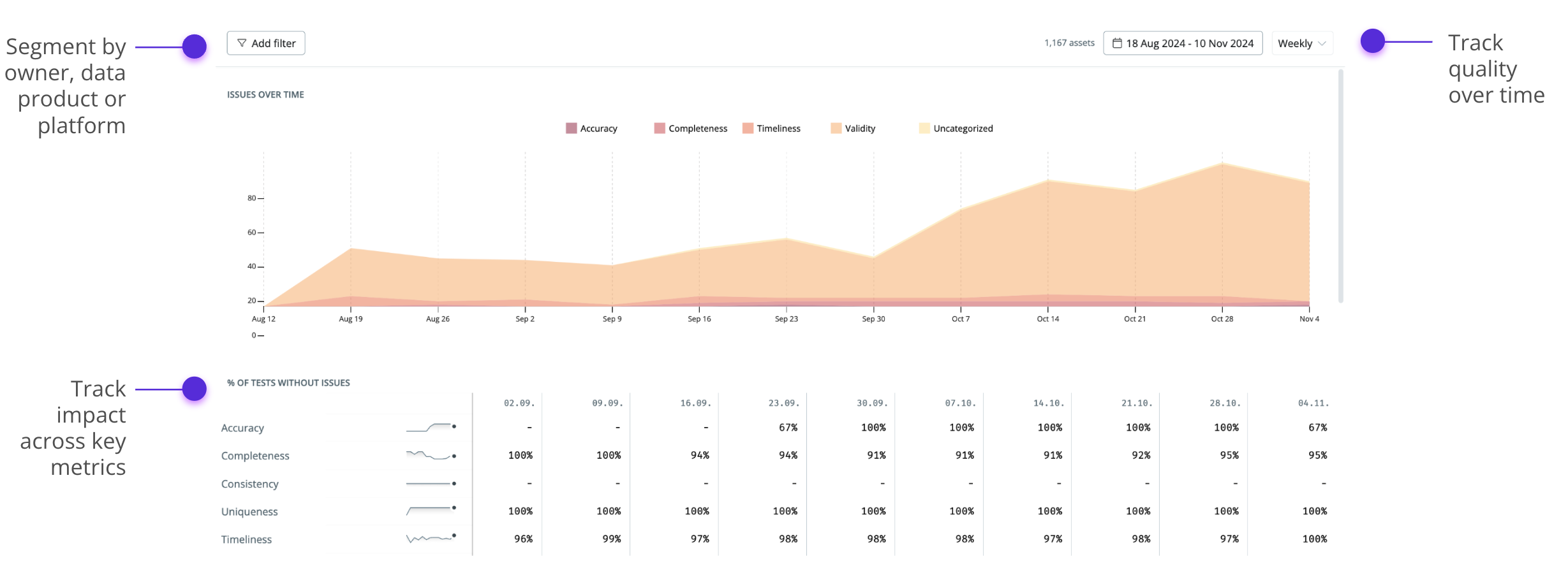- Benchmark and monitor the performance of your most important data assets
- Keep stakeholders in the loop as you’re making improvements by tracking key metrics
- Identify gaps and segment your quality data across teams, platforms, and data products

Data quality dimensions
All metrics are broken down into automated groupings| Dimension | Description |
|---|---|
| Accuracy | Ensures data correctly represents real-world facts (e.g., accepted_values test for valid statuses, custom SQL checks for calculated metrics). |
| Completeness | Confirms all necessary data is present (e.g., not_null test for critical columns, row count checks). |
| Uniqueness | Ensures no duplicate entries exist (e.g., unique test on primary key columns). |
| Timeliness | Checks data freshness and update frequency (e.g., dbt source freshness test, custom timestamp lag checks). |
| Validity | Confirms data adheres to formats and rules (e.g., accepted_values test for categorical data, regex-based custom tests for formatting). |
| Uncategorised | Everything else |
Data quality metrics
SYNQ offers a wide range of metrics to track the quality of your data- % of tests without issues — This metric helps monitor the overall health and stability of the system. A low percentage indicates that you have systemic issues, or should reevaluate if certain tests are needed.
- Number of tests — This reflects the breadth and scope of testing coverage, showing how thoroughly the system is tested.
- Number of tests with issues — Tracking tests with issues provides a direct view into potential problem areas within your stack. A high or increasing count can indicate recurring weaknesses or instability in certain areas, highlighting where teams should prioritize fixes or additional safeguards.
- New and resolved issues — This metric reveals the rate of new issues and resolution, indicating your team’s responsiveness to issues. An ideal balance shows that new issues are resolved quickly, while an imbalance with more new issues than resolved ones can indicate growing technical data debt.
- # incidents — Unlike data test errors, incidents are explicitly declared by you. Counting the number of incidents gives you an indication of how many severe issues you’ve had across key parts of your business.
Actioning data quality insights
- Segment your insights — Use the
Add Filterfunctionality to segment insights by the owner, data product, and platform. This helps make the insights actionable and focused. - Create data quality run books – If you’re in a larger team, include clear steps around addressing each data quality dimension so it’s clear for everyone. For example, if the Timeliness score is low, you can recommend steps such as adding a dbt source freshness check or an automated freshness monitor.